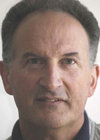Problem Solver
Mike Cirella

Areas Mike Cirella is Knowledgeable in:
photography, digital imaging, displays, novel tutorial formats, business planning, product definition, market assessment, fiber optics, light measurement, radiometry, photometry, photonics, optics, lasers, graphics, copywriting, technical writing, ultra wideband radar and communications
Techniques Mike Cirella Uses:
Brainstorming, crowd-sourcing, Internet search, experiential matching; following the sequence of steps below:
· define the problem clearly
· describe an 'ideal' solution
· disassemble it to smaller pieces
· search for existing technology for each piece
· choose the best solution/technology for each piece
· finally, fill in the spaces to create a combination that approaches the ideal
As Thomas Alva Edison once said: "Keep on the lookout for novel ideas that others have used successfully. Your idea has to be original only in its adaptation to the problem you’re working on."
· define the problem clearly
· describe an 'ideal' solution
· disassemble it to smaller pieces
· search for existing technology for each piece
· choose the best solution/technology for each piece
· finally, fill in the spaces to create a combination that approaches the ideal
As Thomas Alva Edison once said: "Keep on the lookout for novel ideas that others have used successfully. Your idea has to be original only in its adaptation to the problem you’re working on."
Mike Cirella's Problem Solving Skills:
- Acoustics - experience designing and testing ultrasonic ranging systems.
- Internet - web design, content copywriting, photography for the web.
- Optical Science - optics for photographic systems, light measurement, fiber optics for telecommunications, wavelength division
- Business - Extensive product planning, product management, marketing and sales of technical products (engineer to engineer sale
- Photography - deep experience with optical, radiometry and colorimetry problems affecting photographic systems.
Mike Cirella's Problem Solving Experience:
- Electronics – Vending Machines – Currency Recognition
Mars Electronics: Produced the world’s first all-electronic coin recognition device (no moving mechanical parts) to leapfrog unreliable opto-mechanical control of vending machines and pay telephones. Expanded application to paper currency recognition; further enhancing the consumer experience.
. - Computers–Telephony–Semiconductors–Electrical Power Systems
AtariTel (spin out from Atari Computers): developed world’s first video-telephone targeting high end consumer markets, utilizing custom digital processing and data compression electronics; positioned as premier product in a newly created line of residential telephone equipment that used the electrical power grid in buildings as a local area network (LAN). This innovation was achieved well before the rest of the market (1984 – the year AT&T was broken up by Justice Department decree).
. - Chemistry – Optics – Electronics – Semiconductors
Polaroid instant photography: the world’s first folding instant camera with sophisticated photometer exposure control system enabled by first mass produced consumer product using custom integrated circuits. Enabled broad application of customized semiconductor chips to camera system photographic exposure control, even in the latest digital imaging cameras that have since displaced much of traditional photographic film use.
. - Plastic Web Production – Mechanical Engineering – Biofilter – Sunglasses
The process of manufacturing sunglasses involves plastic web handling, coating, laminating, slitting and molding. Practical knowledge of the methods in one industry applied to a problem in another (how to make a low cost semi-porous plastic sheet for biofiltering applications) won an Innocentive ideation award. Cross-pollination of ideas and creative thinking leads to solutions from unlikely sources.
. - Energy – Off-Grid – Electronics – Coin Recognition
What does coin recognition have to do with off-grid power generation? Not much, but knowledge of the inner workings of modern coin recognition methods that result in a robust device with no moving parts led to a solution accepted by a Rockefeller Foundation sponsored InnoCentive challenge to invent a low cost, reliable charging device that used wind and hydro energy in remote third world locations.
. - Lasers – Military Optics – Radiometry – Photography – Crystallography
Xenon flash pumped solid state YAG crystal lasers used for military target designators require super cut-off filters to avoid exposure during covert field operations. Applying previous knowledge of xenon flash lamps in photographic systems, a suitable filter was designed and produced.
. - Photography – Colorimetry – Electronics
Developed world’s first microprocessor-based color light meter for professional photographers and cinematographers, incorporating colorimetry (tri-stimulus value calculation via electronics) and relating to traditional Kodak Wratten color correction filters for ease of use by the photographic professional.
. - Physics – Optics – Telecommunications
Lasertron (spin out from MIT Lincoln Labs and acquired by Corning), SDL (spin out from Spectra-Physics and acquired by JDSU), Pirelli Optical Systems (acquired by Cisco): First major deployment of erbium doped fiber optical amplifiers pumped by 980nm diode lasers with telecom-grade reliability; enabled widespread deployment of high bandwidth optical networks at low cost and minimal disruption to existing plant infrastructure.
. - Photography - Colorimetry - Human Vision / Color Perception- Computer Monitor Calibration
Created a method for drug manufacturer to better understand patient perception of color differences in tablets that are perceived as unacceptable for use. Received an InnoCentive Award.
. - Acoustics – Noise & Vibration Control – Biophysics – Photography
Quantified intensity/dosage level of Polaroid ultrasonic rangefinder; determined safe level of operation to prevent harmful biophysical effects on photographic subjects. Adopted noise and vibration data from government study of ultrasound atmospheric propagation from military helicopter blades to formulate gain calibration tables that adjusted camera sensitivity over temperature and relative humidity changes; enabling on-time production start-up.
. - Materials Processing – Vacuum Furnaces – Hyperbaric Chambers
Provided furnace chamber capital equipment adapted from metals processing techniques to sinter ceramic composite parts lighter and stronger than pure metal version, e.g. turbo-charger impeller in automobiles.
.
